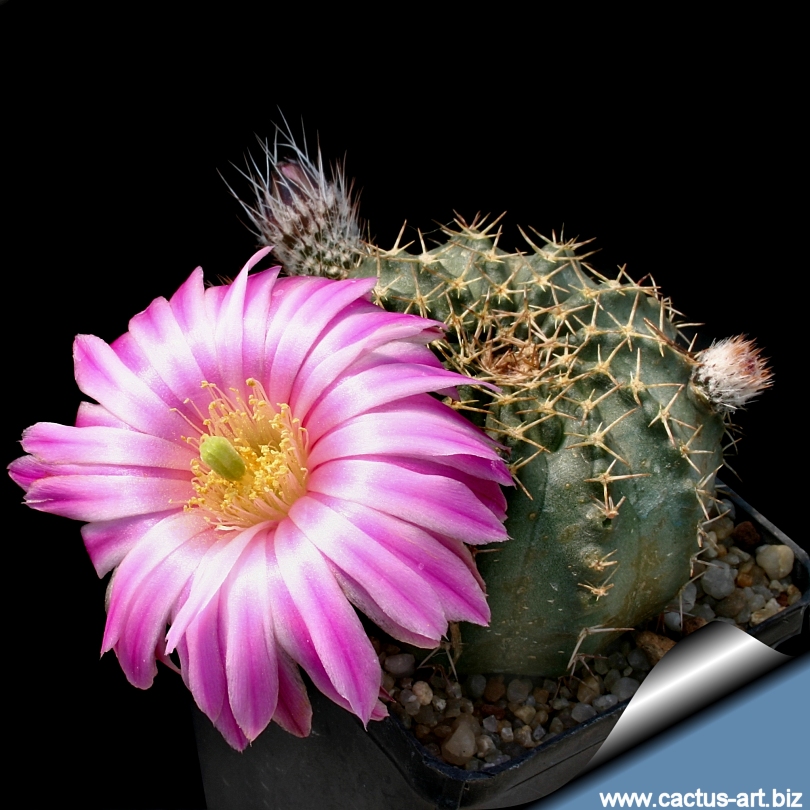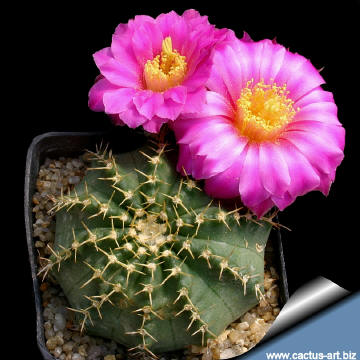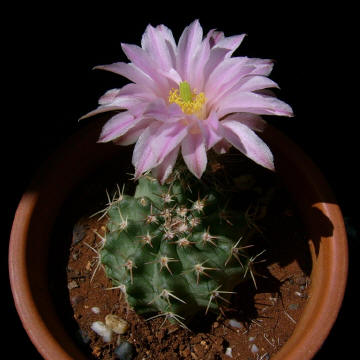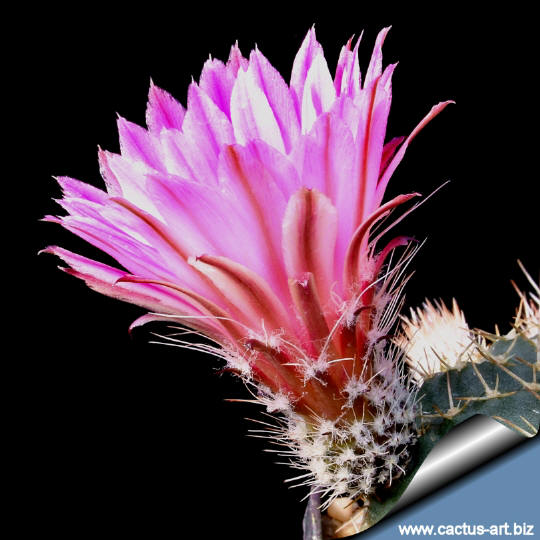|
|
|

E. pulchellus var. Amoenus are small growing cacti with flat globular
bodies and short pale spines. They are very popular in collections as
they remain relatively compact and bear many spectacular big
pink/purple/red flowers.
|
|
Description: Solitary
or slowly clumping
Stems: Flat globular up to 6 cm (but
cultivated plants are frequently higher), 5-7cm in diameter, bluish
green when young;
Ribs: 9 to 13;
Areoles: 5 to7 mm inch apart; 3 to 7
pale yellowish spines.
Root: It has a strong taproot.
Flowers: Abundant pink or purple/red (rarely white) flowers,
up to 6 cm in diameter.
Note: Many of the plants usually known in
cultivation as
"Echinocereus amoenus" are instead a form of
Echinocereus weinbergii.
|
 |

Photo and ©
copyright by
Mladen Turcinovic (Croatia)
|
Cultivation: It has a strong tap root and should have a deep pot to
accommodate it. Needs porous well drained soil, water carefully, too much water will make it rot. Keep dry at minimum
temperature of 5° C in winter although will tolerate brief periods to -10
degrees. Sun Exposure: Full sun to light shade.
Propagation: It grow easily from seed or cutting (if available) |
|


Advertising
|
|
|
|
|
Family:
Cactaceae (Cactus
Family)
Scientific name: Echinocereus
pulchellus var. amoenus (Dietrich) Förster ex Schumann 1897
Origin: Mexico (northern Oaxaca, Puebla, Hidalgo, San Luis
Potosi, and Queretaro)
Ecology: It is a geophyte cactus with a
swollen underground storage taproot, in the wild tends to
disappear completely in the ground in time of drought.
Conservation status: Listed in
CITES appendix 2.
Synonyms:
- Echinocereus amoenus (Dietrich)
Weber ex Haage 1892
= Echinopsis amoena Dietrich 1844:187-188.
TL: Mexico, Hidalgo, near San Mateo 7500 ft., Ehrenberg (?)
= Cereus amoenus (Dietrich) Hemsley 1880:540
- Echinopsis pulchella var. flore kermesina
Haage ex Förster 1846 pro syn.
- Echinopsis pulchella var. amoena
(Dietrich) Förster 1846
= Echinocereus pulchellus var. amoenus (Dietrich)Förster
ex Schumann 1897
= Echinocereus pulchellus ssp. amoenus (Dietrich)Blum
1997 Seed
list. nom. nud.
- Echinopsis pulchella var. rosea
Labouret 1853 pro syn.
- Echinocereus amoenus var. aguirre
Zehnter & Künzler Catalog nom. nud.
= Echinocereus aguirrei
|
|
|
 |
|
Photo of conspecific
taxa, varieties of Echinocereus pulchellus.
- E. pulchellus ssp. pulchellus has stems that are
2,5-5 cm thick with 9 to 12 ribs and 3 to 7 inconspicuous spines per
areole. The flowers are pink or white.
-
E. pulchellus ssp. acanthosetus has stems that are 2 to
4cm thick with 9 ribs usually and 5 to 8 flailing hairlike spines. The
flowers are magenta to white.
- E. pulchellus ssp. sharpii has darker colored
stems in comparison to the other subspecies that are 2 to 6cm thick
with 11 to 17 ribs and 7 to 14 spines per areole. The flowers are
magenta to white.
-
E. pulchellus ssp. weinbergii has stems that are 5
to 15 cm thick with 14 or 15 ribs and 8 to 11 spines per areole. The
pink diurnal flower petals are narrowly acute in shape.
- E. pulchellus
ssp. amoenus has 15 cm stems, 10 to 14 ribs & on the young
areoles it has 6 to 8 short spines with the lower spine being the
longest. The older areoles are devoid of spines. The flowers are
magenta.
Form & Cultivars:
|
|